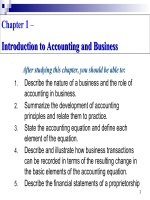ch01 introbus
Bạn đang xem bản rút gọn của tài liệu. Xem và tải ngay bản đầy đủ của tài liệu tại đây (461.65 KB, 33 trang )
Part I: Organization of a Business
Planning A Business
Copyright © 2004 South-Western. All rights reserved.
Introduction to
J eff Madura
Business
3e
1
Organization of a Business
Copyright © 2004 South-Western. All rights reserved.
1–2
Learning Goals
• Identify
key business stakeholders.
• Describe key business functions.
• Explain how to develop a business
plan.
Copyright © 2004 South-Western. All rights reserved.
1–3
Business Defined
A business is an enterprise that
provides products or services
desired by customers.
Copyright © 2004 South-Western. All rights reserved.
1–4
Key Business Decisions
• Product
– What type of product should be produced?
• Production
– How should the product be produced?
• Promotion
– How should the product be promoted?
• Financing
– How should the company obtain funds to
finance the cost of producing the product?
Copyright © 2004 South-Western. All rights reserved.
1–5
Business Decisions
Copyright © 2004 South-Western. All rights reserved.
1–6
Key Stakeholders
• Owners
– Entrepreneurs
– Co-owners
– Stockholders
• Creditors
• Employees
– Managers
• Suppliers
• Customers
Copyright © 2004 South-Western. All rights reserved.
1–7
Interaction among Owners,
Employees, Customers, Suppliers,
and Creditors
Copyright © 2004 South-Western. All rights reserved.
Exhibit 1.1
1–8
Creating a Business Idea
• Identify
a competitive advantage.
• Differentiate the product or service
from competitors.
• Determine necessary resources.
• Assess feasibility of the idea.
Copyright © 2004 South-Western. All rights reserved.
1–9
Copyright © 2004 South-Western. All rights reserved.
e-business
business online
1–10
Success Stories
•
•
•
Domino’s Pizza
– Managhans bought bankrupt pizza parlor
– Started with little funding
– Now generates sales of $1 billion per year
Jeremy’s Micro Batch Ice Cream
– Applied microbrewery concept to ice cream
– Makes ice cream in small batches, sold in limited
editions
Glow Dog, Inc.
– Sells light-reflective clothing for pets
– After two years, average annual sales of $1 million
Copyright © 2004 South-Western. All rights reserved.
1–11
Lessons to Remember
• Successful
businesses do not
require a great invention.
– Many focus on making life more convenient
for customers.
• Some
business ideas will fail—but
entrepreneurs can learn from
failures and make revisions.
Copyright © 2004 South-Western. All rights reserved.
1–12
Impact of Technology
• Technology
defined
– Knowledge or tools used to produce
products and services
• Information
technology
– Represents over 1/3 of the growth in U.S.
output
– Reduces cost of producing products
– Workers in technology industries earn more
than workers in other industries.
Copyright © 2004 South-Western. All rights reserved.
1–13
Impact of Technology
• E-business
or e-commerce
– Use electronic communications to produce or
sell products and services
Sales to individual customers
B2B e-business: transactions between a business
and its suppliers
Generates $301 billion in revenue and creates 1.2
million jobs each year
Copyright © 2004 South-Western. All rights reserved.
1–14
Successful E-Businesses
Started out small
• Created to sell a product or service that
was not offered by competitors
• Transformed how traditional firms
conducted business
•
–
–
–
–
Improved communication with customers
Improved information flow
Improved efficiency
Complemented traditional business operations
Copyright © 2004 South-Western. All rights reserved.
1–15
E-Business Examples
•
Amazon
– Online seller of books, music and other products
– Low overhead costs allow price discounting
•
Yahoo!
– Internet search engine and the most visited site on
the Web
– Offers variety of services - free email, web page
hosting, custom-designed start-up pages
– Generates revenue by selling advertising
•
eBay
– Online auction service
Copyright © 2004 South-Western. All rights reserved.
1–16
Key
Partners
Key
Activities
Value
Proposition
Customer
Relationships
Key
Resources
Cost
Structure
Digital
Channels
And
Traditional
Channels
Revenue
Streams
Customer
Segments
Key
Partners
Business
Model
Key
Activities
Platform
Management
Managing
Services
Value
Proposition
Customer
Relationships
Targeted Ads
Free Research
Open
Accessible
Free
Monetizing
Content
Advertisers
Web Surfers
Content
Owners
Key
Resources
Distibution
Channel
Search Engine
Digital
Channels
Cost
Structure Platform Costs
Customer
Segments
Revenue
Streams
Keyword Auctions and Adwords
Key
Partners
For Air Asia
Hotels and
budget
airports
Key
Activities
Value
Proposition
Maintanence
And Flight
Speed
Cost
Accessibility
Convenience
IT System
Customer
Relationships
Key
Resources
Friendly and
Open
Digital
Channels
And
Traditional
Channels
Online System
Flexible
Employees
Online Ticketing
Cost
Structure
Revenue
Streams
Leasing and Operations
Tickets and Hotels
Customer
Segments
Lower and
Medium
Income
People who travel
by bus or
train
Key Functions of Business
•
Management
– Means by which employees and other resources
are used by the firm
•
Marketing
– Means by which products and services are
developed, priced, distributed, and promoted to
customers
•
Finance
– Means by which firms obtain and use funds for their
business operations
Copyright © 2004 South-Western. All rights reserved.
1–20
Key Functions of Business
• Accounting
– Summary and analysis of the firm’s financial
condition
– Used to make various business decisions
• Information
systems
– Information technology, people, and
procedures that provide appropriate
information to make effective decisions
Copyright © 2004 South-Western. All rights reserved.
1–21
How Business Decisions
Affect a Firm’s Earnings
Copyright © 2004 South-Western. All rights reserved.
Exhibit 1.4
1–22
Common Business
Decisions
• Management
Decisions
– What equipment is needed?
– How many employees should be hired?
– How can employees be motivated to perform
well?
Copyright © 2004 South-Western. All rights reserved.
1–23
Common Business
Decisions
• Marketing
Decisions
– What price should be charged?
– Should the product be changed to be more
appealing to customers?
– Should the firm use advertising or some
other strategy to promote its product?
Copyright © 2004 South-Western. All rights reserved.
1–24
Common Business
Decisions
• Finance
Decisions
– Should financial support come from the sale
of stock or from borrowing money or some
combination?
– Should the firm attempt to obtain borrowed
funds for a short-term or long-term period?
– Should the firm invest funds in a new
business project?
Copyright © 2004 South-Western. All rights reserved.
1–25









